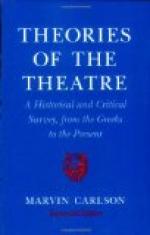But with the growth of the Drama of Illusion, produced within a picture-frame proscenium, actors have come to recognise and apply the maxim, “Actions speak louder than words.” What an actor does is now considered more important than what he says. The most powerful moment in Mrs. Fiske’s performance of Hedda Gabler was the minute or more in the last act when she remained absolutely silent. This moment was worth a dozen of the “real speeches” that were sighed for by the old actor in Trelawny. Few of those who saw James A. Herne in Shore Acres will forget the impressive close of the play. The stage represented the living-room of a homely country-house, with a large open fireplace at one side. The night grew late; and one by one the characters retired, until at last old Nathaniel Berry was left alone upon the stage. Slowly he locked the doors and closed the windows and put all things in order for the night. Then he took a candle and went upstairs to bed, leaving the room empty and dark except for the flaming of the fire on the hearth.
Great progress toward naturalness in contemporary acting has been occasioned by the disappearance of the soliloquy and the aside. The relinquishment of these two time-honored expedients has been accomplished only in most recent times. Sir Arthur Pinero’s early farces abounded with asides and even lengthy soliloquies; but his later plays are made entirely without them. The present prevalence of objection to both is due largely to the strong influence of Ibsen’s rigid dramaturgic structure. Dramatists have become convinced that the soliloquy and the aside are lazy expedients, and that with a little extra labor the most complicated plot may be developed without resort to either. The passing of the aside has had an important effect on naturalness of acting. In speaking a line audible to the audience but supposed to be unheard by the other characters on the stage, an actor was forced by the very nature of the speech to violate the illusion of the stage picture by stepping out of the frame, as it were, in order to take the audience into his confidence. Not until the aside was abolished did it become possible for an actor to follow the modern rule of seeming totally oblivious of his audience.
There is less logical objection to the soliloquy, however; and I am inclined to think that the present avoidance of it is overstrained. Stage soliloquies are of two kinds, which we may call for convenience the constructive and the reflective. By a constructive soliloquy we mean one introduced arbitrarily to explain the progress of the plot, like that at the beginning of the last act of Lady Windermere’s Fan, in which the heroine frankly tells the audience what she has been thinking and doing between the acts. By a reflective soliloquy we mean one like those of Hamlet, in which the audience is given merely a revelation of a train of personal thought or emotion, and in which the dramatist makes no utilitarian reference to the structure of the plot. The constructive soliloquy is as undesirable as the aside, because it forces the actor out of the stage picture in exactly the same way; but a good actor may easily read a reflective soliloquy without seeming in the least unnatural.




